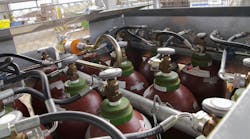© Jan Zahradka | Dreamstime.com
One reason fuel gases are so useful is they easily ignite. That is also one reason they are so dangerous. A flame need not be present, a hot surface (only 600ºF) can do the job. These gases ignite at very low concentrations, so even if ventilation seems adequate it might not be.
Adding further danger, these gases are compressed at high pressures. Hydrogen, for example, is compressed up to 2,000 psi. Acetelyne, the gas people most commonly think of when you say “gas welder,” is compressed at 250 psi. That sounds paltry, especially compared to what hydrogen is compressed at, but acetylene becomes unstable at only 25 psi. Below are safety tips when handling acetelyne.
Bottle use
- Always stand the bottle in the upright position, and secure it properly so it doesn’t tip over. Among other things, this prevents you from releasing shots of liquid, which would greatly increase the amount of gas in the air.
- If you inadvertently release a shot of liquid, immediately close the valve. Ventilate the area to remove the gas, and leave the area until a safe concentration can be confirmed. Report the incident to your foreman and to the correct authority, such as the area supervisor.
- Never handle a bottle by the gas valve. You could break the valve, causing a massive leak.
- Leave the valve cap on unless you need to use the bottle at that time. When you are not using the gas, disconnect the hoses, remove the regulator, and screw on the cap.
- Handle compressed gas cylinders as if your life depends on the care you takeecause it does. Dropping one on the floor can break the valve. When the valve breaks on a bottle that has much of anything in it, you’ve got a steel rocket that can go through walls while spewing explosive gas in high concentrations.
Hoses
- Inspect hoses before connecting them. Look for cracks, kinks, and stress marks. A stress mark will be some kind of deformity like a blister or crease. Replace hoses that have any of these issues.
- Hoses have a bend radius you must respect. You don’t need to look up in some table what the bend radius is for a given hose. Loosely coiling a hose will produce almost no resistance pressure. When you feel resistance, you need to back off. Do not wrap hoses tightly. Exceeding their bend radius will result in a weakened hose wall.
- Don’t use saddle straps, cable ties, or other unapproved devices with hoses. These can pinch the hose wall, causing it to weaken. Using duct tape is also not recommended, because the natural tendency when removing it is to pull in a manner that will stress the hose wall.
- Don’t clean them with WD-40; this and similar products will degrade the hose material.
Gas meters
- These are often misused. Taking an “ambient” gas reading will almost certainly give you an incorrect picture of the gas hazard. If you do not have training specific to using a gas meter for a particular gas, don’t use the meter in the first place.
- Specific training for using a gas meter to detect a specific gas will include knowing where to look for that gas. You could be standing under a hydrogen cloud, above a pool of a heavier gas, or both. A pool of heavier gas can collect in the oddest places, including in your gang box.
Thawing
- If an acetylene valve freezes shut, thaw it with lukewarm water. Pour the water over the valve, not the cylinder.
- Never use a flame to thaw a valve on an compressed gas bottle.
- Tapping on the valve with pliers to “free it up” may create the spark that lights you up. It can also damage the valve. If pouring warm water over the valve doesn’t fix the problem, take the whole assembly (on the bottle cart) to the tool crib to have it properly checked out.
Transporting
- Prepare cylinders for transportation by disconnecting the hoses, removing the regulator, and capping the valve. Then secure the bottles to their cart using the provided chain, strap, or other means.
- If you must lift the bottles, try lifting the cart they are secured to. If that is not practical, have another person or two also lift the bottles but only by holding the bottles. In no case should anyone attempt to lift or move a bottle by its valve cap.
- Before you move the cart, ensure there is a clear path between where you are and where you are going. You might break the trip down into several segments if it’s not practical to clear the entire path at once.
- When it comes to transporting on stairs, clear the entire stairway from landing to landing and red-tape or red-rope that section of stairway so there is no foot traffic or anyone else on those stairs while your bottles are on those stairs. If others will not cooperate, contact the nearest foreman for assistance. The stairway must be clear of people before you bring the bottles up or down it. Be sure to remove the red tape or red rope once the bottles are off that section of stairway, and thank people for waiting.
Sponsored Recommendations
Sponsored Recommendations




